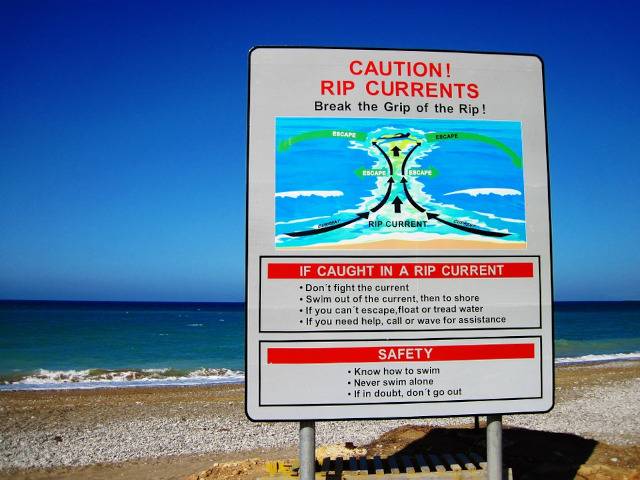Spot A Rip At The Beach

What Is A Rip And How Do You Spot One At The Beach
The sea is a vast body of water. In fact, the sea covers 71% of the planet! In short, you are going to encounter it at some point in your life. However, while it is enchanting and most people enjoy a fabulous day at the beach, there are dangers that can ruin any day.
One of the biggest hazards at the beach is the rip current, also known as a rip. It's rated as the most hazardous issue at the beach by 80% of Australians. Despite this, 24% of Australian beach goers admit they don't know what to look for and 14% of Australians simply forget to check the water.
That's a staggering figure when you realize there were 136 coastal drowning deaths in 2020.
What Is A Rip?
Water generally flows onto the shore as the tide comes in and away from the shore as the tide goes out. It's a predictable pattern and, in most cases not something to be too concerned about.
However, there are pockets of water that behave differently. The rip is one of these. Instead of going toward the shore, it moves away. The real issue is that these currents are hard to spot and very powerful. If you find yourself in a rip current you will quickly be carried out to sea.
At this point, you are likely to panic and you'll be glad you have chosen a beach with a surf lifesaver. They can save your life and it's the reason why people donate to Surf Life Saving Australia.
Dealing With A Rip Current
Rip currents are very powerful and you are not going to be able to swim against them. When you realize you are in a rip current you are likely to panic and start swimming back to shore. Unfortunately, you won't be able to swim against the current and will simply tire yourself out, increasing the risk of drowning.
Instead, you need to stay calm and start swimming parallel to the beach. The current will still carry you out to sea but you will gradually break free, simply by swimming sideways to the current.
The alternative is to lie on your back and float with the rip. It will lose its strength as it gets out to sea.
You'll then be able to start swimming back to shore and wave for the assistance of the surf lifesavers.
Identifying A Rip Current
Rips change frequently, moving from one spot to another and even changing their shape. However, the majority of rips will display the following features:
• The water will appear deeper and darker
• You'll notice a rippled surface and very few waves outside the area
• Sand, foam, and other debris floating out at sea
• Limited waves breaking, if any, in the rip
Of course, the list isn't definitive and a rip may not display all these symptoms. That's why you should be aware of the basic rules regarding dealing with rips.
In short, monitor the sea and, if you find yourself in a current stay calm. You should try swimming parallel to the beach first and, if that doesn't appear to be working, go with the current until you can break free and swim carefully back to the beach or attract the surf lifesavers to help you.
One of the biggest hazards at the beach is the rip current, also known as a rip. It's rated as the most hazardous issue at the beach by 80% of Australians. Despite this, 24% of Australian beach goers admit they don't know what to look for and 14% of Australians simply forget to check the water.
That's a staggering figure when you realize there were 136 coastal drowning deaths in 2020.
What Is A Rip?
Water generally flows onto the shore as the tide comes in and away from the shore as the tide goes out. It's a predictable pattern and, in most cases not something to be too concerned about.
However, there are pockets of water that behave differently. The rip is one of these. Instead of going toward the shore, it moves away. The real issue is that these currents are hard to spot and very powerful. If you find yourself in a rip current you will quickly be carried out to sea.
At this point, you are likely to panic and you'll be glad you have chosen a beach with a surf lifesaver. They can save your life and it's the reason why people donate to Surf Life Saving Australia.
Dealing With A Rip Current
Rip currents are very powerful and you are not going to be able to swim against them. When you realize you are in a rip current you are likely to panic and start swimming back to shore. Unfortunately, you won't be able to swim against the current and will simply tire yourself out, increasing the risk of drowning.
Instead, you need to stay calm and start swimming parallel to the beach. The current will still carry you out to sea but you will gradually break free, simply by swimming sideways to the current.
The alternative is to lie on your back and float with the rip. It will lose its strength as it gets out to sea.
You'll then be able to start swimming back to shore and wave for the assistance of the surf lifesavers.
Identifying A Rip Current
Rips change frequently, moving from one spot to another and even changing their shape. However, the majority of rips will display the following features:
• The water will appear deeper and darker
• You'll notice a rippled surface and very few waves outside the area
• Sand, foam, and other debris floating out at sea
• Limited waves breaking, if any, in the rip
Of course, the list isn't definitive and a rip may not display all these symptoms. That's why you should be aware of the basic rules regarding dealing with rips.
In short, monitor the sea and, if you find yourself in a current stay calm. You should try swimming parallel to the beach first and, if that doesn't appear to be working, go with the current until you can break free and swim carefully back to the beach or attract the surf lifesavers to help you.
MORE





